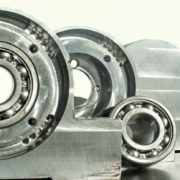Passivation of Stainless Steel
How It Works
 By adding chromium to steel, a new breed of “stain-less” steel was born over a century ago. The added chromium combines with oxygen in the atmosphere and forms an invisible layer called passive film, making the steel resistant to rust.
By adding chromium to steel, a new breed of “stain-less” steel was born over a century ago. The added chromium combines with oxygen in the atmosphere and forms an invisible layer called passive film, making the steel resistant to rust.
A clean, freshly machined and polished stainless steel part will naturally acquire this protective film. However, this little miracle of chromium and oxygen atoms working together to protect steel from corrosion has limitations.
When stainless steel parts are fabricated by cold forming or machining, contaminants are introduced. Your shop floor, despite your stringent cleaning standards, has small particles of iron-containing dirt from cutting tools that can stick to the surface of stainless steel. Well-kept shop tools also contain corrosive-inducing steel which can adhere to your stainless steel parts.
Besides physical abrasion, surface damage is also caused by chemical reactions and expansion and contraction from heating and cooling processes. Rusting will result if the damage happens faster than the passive layer can naturally reform.
If the surface damage isn’t repaired and the foreign particles aren’t removed, a corrosive attack can start. It’s an insidious process that goes undetected to the human eye, but can eventually lead to rusting.
How to Protect Your Stainless Steel Parts
Passivation is a chemical process that protects your stainless steel by applying an acid and forcing the conversion of a uniform protective oxide layer, maximizing the corrosion resistance that steel already has.
This chemical treatment of a mild oxidant or acid must follow a cleaning process that removes oil, grease, and other residue left behind from fabrication and machining. Once the cleaning is complete, the acid is applied to the surface to enhance the spontaneous formation of the protective passive film.
Two types of acids are used to regenerate the passive layer. Both nitric acid and citric acid will effectively remove iron and its compounds from the surface.
Nitric acid is the most common method for passivation and is widely used for aerospace industry parts. It quickly dissolves all iron compounds and other trace metals on the surface of the stainless steel, regenerating the chromium oxide layer at the same time. Nitric acid requires high temperatures and an extended application time.
Citric acid is a safer and more environmentally friendly option that is effectively used for parts in the medical device industry. Because it’s not an oxidizer, citric acid relies on natural air oxidation to build up the corrosion protective layer.
The method of passivation you choose depends on the type of stainless steel. Both methods should only be performed by trained and experienced technicians who understand the safety practices and potential hazards.
PTI Industries complies with all industry standards, including EPA requirements for the necessary air and water permits and treatment capabilities. Specifications and verification testing are another critical component of passivation.
If you have any questions on passivation, give us a call at 1-800-318-8438. We will be happy to help you find the solutions you need to protect your stainless steel parts.




Leave a Reply
Want to join the discussion?Feel free to contribute!